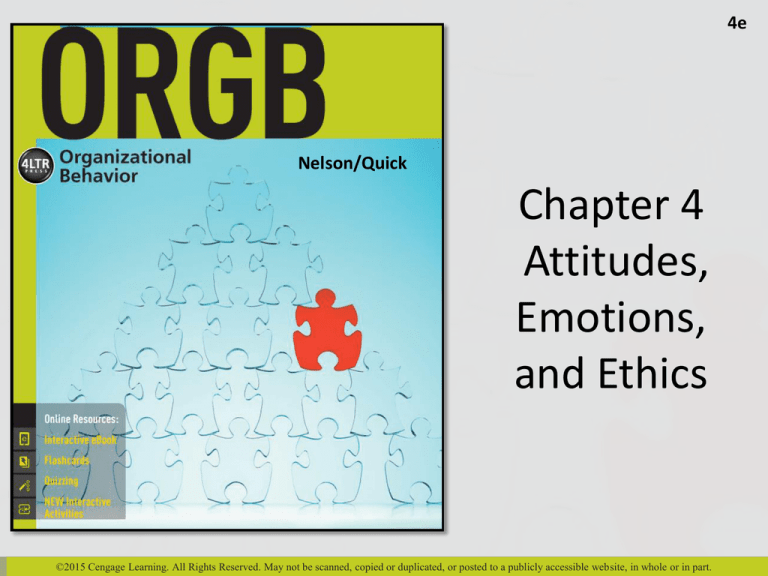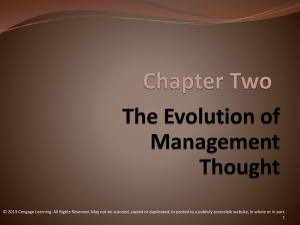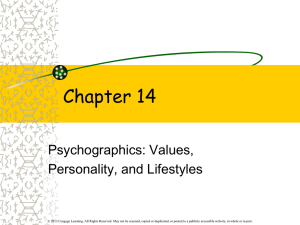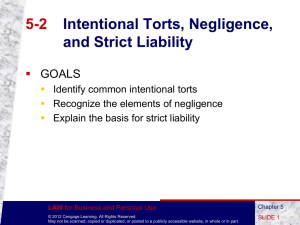
4e
Nelson/Quick
Chapter 4
Attitudes,
Emotions,
and Ethics
©2015 Cengage Learning. All Rights Reserved. May not be scanned, copied or duplicated, or posted to a publicly accessible website, in whole or in part.
Learning Outcomes
Explain the ABC model of an attitude
Describe how attitudes are formed
Identify sources of job satisfaction and commitment
Distinguish between organizational citizenship and
workplace deviance behaviors
Identify the characteristics of the source, target, and
message that affect persuasion
©2015 Cengage Learning. All Rights Reserved. May not be scanned, copied or duplicated, or posted to a publicly accessible website, in whole or in part.
2
Learning Outcomes
Discuss the definition and importance of emotions
at work
Contrast the effects of individual and organizational
influences on ethical behavior
Identify the factors that affect ethical behavior
©2015 Cengage Learning. All Rights Reserved. May not be scanned, copied or duplicated, or posted to a publicly accessible website, in whole or in part.
3
Learning Outcome
Explain the ABC model of an attitude
©2015 Cengage Learning. All Rights Reserved. May not be scanned, copied or duplicated, or posted to a publicly accessible website, in whole or in part.
4
Attitude
Psychological tendency expressed by evaluating
something with a degree of favor or disfavor
Affect: Emotional component of an attitude
Cognitive dissonance: State of tension produced
when an individual experiences conflict between
attitudes and behavior
©2015 Cengage Learning. All Rights Reserved. May not be scanned, copied or duplicated, or posted to a publicly accessible website, in whole or in part.
5
Beyond the Book:
Bad Attitude
Larry Johnson was a highly accomplished football player for
the Kansas City Chiefs – a former number one pick, a twotime Pro Bowl participant, and one of the most productive
running backs in 2005 and 2006.
In 2007 and 2008, Johnson had two relatively unproductive,
injury-marred seasons. And yet, it was his attitude, not his
productivity, that led to his release from the Chiefs.
Constant complaints about salary, personal attacks on the
coach, slurs against homosexuals, mocking of fans, charges
of abusing women—all of these actions ensured that
Johnson would no longer be welcome with the Kansas City
organization.
©2015 Cengage Learning. All Rights Reserved. May not be scanned, copied or duplicated, or posted to a publicly accessible website, in whole or in part.
6
Table 4.1 - The ABC Model of an
Attitude
Adapted from M. J. Rosenberg and C. I. Hovland, “Cognitive, Affective, and Behavioral Components of Attitude,” in M. J. Rosenberg, C. I. Hovland,
W. J. McGuire, R. P. Abelson, and J. H. Brehm, eds., Attitude Organization and Change (New Haven, Conn.: Yale University Press, 1960). Copyright
1960 Yale University Press. Used with permission.
©2015 Cengage Learning. All Rights Reserved. May not be scanned, copied or duplicated, or posted to a publicly accessible website, in whole or in part.
7
Learning Outcome
Describe how attitudes are formed
©2015 Cengage Learning. All Rights Reserved. May not be scanned, copied or duplicated, or posted to a publicly accessible website, in whole or in part.
8
Two Influences on Attitude
Formation
Direct experience - Results in attitudes that are:
Stronger, held more confidently, and more resistant
to change
Active in one’s cognitive processes
Social learning: Deriving attitudes from family, peer
groups, religious organizations, and culture
Modeling - Individuals acquire attitudes by observing
others
©2015 Cengage Learning. All Rights Reserved. May not be scanned, copied or duplicated, or posted to a publicly accessible website, in whole or in part.
9
Learning by
Observing a Model
The learner must:
Focus on the model
Retain what was observed
Reproduce the behavior through practice
Be motivate
©2015 Cengage Learning. All Rights Reserved. May not be scanned, copied or duplicated, or posted to a publicly accessible website, in whole or in part.
10
Attitude–Behavior Correspondence
Requirements
Attitude specificity
• The more specific the attitude, the stronger is its link to behavior
Attitude relevance
• Attitudes that address an issue of self-interest prompt behavior
consistent with the expressed attitude
Timing of measurement
• The shorter the time between the attitude measurement and observed
behavior, the stronger the relationship
©2015 Cengage Learning. All Rights Reserved. May not be scanned, copied or duplicated, or posted to a publicly accessible website, in whole or in part.
11
Attitude–Behavior Correspondence
Requirements
Personality factors
• Self-monitoring affects the consistency between attitudes and behavior
is
Social constraints
• Social context provides information about acceptable attitudes and
behaviors
©2015 Cengage Learning. All Rights Reserved. May not be scanned, copied or duplicated, or posted to a publicly accessible website, in whole or in part.
12
Learning Outcomes
Identify sources of job satisfaction and
commitment
Distinguish between organizational
citizenship and workplace deviance behaviors
©2015 Cengage Learning. All Rights Reserved. May not be scanned, copied or duplicated, or posted to a publicly accessible website, in whole or in part.
13
Job (Dis) Satisfaction
Job satisfaction: Pleasurable or positive emotional
state resulting from the appraisal of one’s job
Affected by the job characteristics
Contributing factors
Challenging work, valued rewards, and opportunities
for advancement
Competent supervision and supportive coworkers
Job Descriptive Index (JDI)
Measures the specific facets of satisfaction
©2015 Cengage Learning. All Rights Reserved. May not be scanned, copied or duplicated, or posted to a publicly accessible website, in whole or in part.
14
Work Attitudes
Organizational citizenship
behavior (OCB)
Workplace deviance
behavior (WDB)
• Behavior that is above and
beyond the call of duty
• Satisfied workers are more
likely to engage in OCBs
• Leads to lower turnover
and higher productivity at
the organizational level
• Any voluntary
counterproductive
behavior that violates
organizational norms and
adversely affects
organizational functioning
• Negative events that occur
in an organization trigger
WDB
©2015 Cengage Learning. All Rights Reserved. May not be scanned, copied or duplicated, or posted to a publicly accessible website, in whole or in part.
15
Organizational Commitment
and Job Satisfaction
Organizational commitment
• Strength of an individual’s identification with an organization
Affective commitment
• Based on an individual’s desire to remain in an organization
Continuance commitment
• Based on the fact that an individual cannot afford to leave
Normative commitment
• Based on an individual’s perceived obligation to remain with an
organization
©2015 Cengage Learning. All Rights Reserved. May not be scanned, copied or duplicated, or posted to a publicly accessible website, in whole or in part.
16
Learning Outcomes
Identify the characteristics of the source,
target, and message that affect persuasion
©2015 Cengage Learning. All Rights Reserved. May not be scanned, copied or duplicated, or posted to a publicly accessible website, in whole or in part.
17
Process of Persuasion
Source
New Attitude
Target
©2015 Cengage Learning. All Rights Reserved. May not be scanned, copied or duplicated, or posted to a publicly accessible website, in whole or in part.
18
Characteristics
Source
• Expertise, trustworthiness, and attractiveness
Target
• Level of self-esteem, mood
Message
• Approach used and emotional tone of the message
©2015 Cengage Learning. All Rights Reserved. May not be scanned, copied or duplicated, or posted to a publicly accessible website, in whole or in part.
19
Figure 4.2 - The Elaboration
Likelihood Model of Persuasion
SOURCE: Adapted from R. E. Petty and J. T. Cacioppo, “The Elaboration Likelihood Model of Persuasion,” in L. Berkowitz, ed., Advances in Experimental Social
Psychology, vol. 19 (New York: Academic Press, 1986), 123–205.
©2015 Cengage Learning. All Rights Reserved. May not be scanned, copied or duplicated, or posted to a publicly accessible website, in whole or in part.
20
Learning Outcomes
Discuss the definition and importance of
emotions at work
©2015 Cengage Learning. All Rights Reserved. May not be scanned, copied or duplicated, or posted to a publicly accessible website, in whole or in part.
21
Emotions and Moods
Emotions
• Mental states that include
Moods
• Classified as positive or
feelings, physiological
negative and made up of
changes, and the inclination
various emotions
to act
• Short-lived, intense reactions
• Last longer than emotions
• Do not have a specific cause
to an event
• Have a specific, known cause
• Impact both work attitudes
and work behaviors
©2015 Cengage Learning. All Rights Reserved. May not be scanned, copied or duplicated, or posted to a publicly accessible website, in whole or in part.
22
Emotional Contagion, Emotional
Intelligence, and Emotional Labor
Emotional contagion
• Emotions of one person are transferred to another,
consciously or unconsciously, through nonverbal channels
Emotional intelligence (EI)
• Ability to recognize and manage emotion in oneself and in
others
Emotional labor
• Work that employees do to control their feelings and
expression of emotions in the workplace and is a type of
emotion regulation
©2015 Cengage Learning. All Rights Reserved. May not be scanned, copied or duplicated, or posted to a publicly accessible website, in whole or in part.
23
Learning Outcomes
Contrast the effects of individual and
organizational influences on ethical behavior
©2015 Cengage Learning. All Rights Reserved. May not be scanned, copied or duplicated, or posted to a publicly accessible website, in whole or in part.
24
Ethical Behavior
Acting in ways consistent with one’s personal values
and the commonly held values of the organization
and society
Effects
Firms with good reputations attract more job
applicants
Firms can experience lower returns and slow sales
growth for up to five years as a result of illegal
corporate behavior
©2015 Cengage Learning. All Rights Reserved. May not be scanned, copied or duplicated, or posted to a publicly accessible website, in whole or in part.
25
Beyond the Book:
No Consequences?
On October 1, 2009 David Letterman announced
that he had been having sexual affairs with junior
members of his staff.
There appears, however, to be little fallout from the
admission.
There has been no sanction or warning from CBS,
and Letterman’s ratings are higher than ever.
©2015 Cengage Learning. All Rights Reserved. May not be scanned, copied or duplicated, or posted to a publicly accessible website, in whole or in part.
26
Learning Outcomes
Identify the factors that affect ethical
behavior
©2015 Cengage Learning. All Rights Reserved. May not be scanned, copied or duplicated, or posted to a publicly accessible website, in whole or in part.
27
Ethics and the Individual
Ethical decision making requires following qualities
Competence to identify ethical issues and evaluate
the consequences of alternate actions
Self-confidence to seek out different opinions and
decide what is right
Willingness to make decisions when there is no
unambiguous solution
©2015 Cengage Learning. All Rights Reserved. May not be scanned, copied or duplicated, or posted to a publicly accessible website, in whole or in part.
28
Figure 4.3 - Individual/Organizational
Model of Ethical Behavior
©2015 Cengage Learning. All Rights Reserved. May not be scanned, copied or duplicated, or posted to a publicly accessible website, in whole or in part.
29
Values
Enduring beliefs that a specific mode of conduct is
personally or socially preferable to an opposite
mode of conduct
Instrumental values: Shape acceptable behaviors
that can be used to achieve some goal or end state
Terminal values: Influence the goals to be achieved
or the end states of existence
©2015 Cengage Learning. All Rights Reserved. May not be scanned, copied or duplicated, or posted to a publicly accessible website, in whole or in part.
30
Work Values
Influence individual’s perceptions of right and
wrong on the job
Achievement
Concern for others
Honesty
Fairness
©2015 Cengage Learning. All Rights Reserved. May not be scanned, copied or duplicated, or posted to a publicly accessible website, in whole or in part.
31
Cultural Differences in Values
Collectivist cultures
• Value a person’s contributions to relationships in
the work team
Individualist cultures
• Value a person’s contribution to task
accomplishment
©2015 Cengage Learning. All Rights Reserved. May not be scanned, copied or duplicated, or posted to a publicly accessible website, in whole or in part.
32
Locus of Control
Internal
Belief in personal control and personal responsibility
Resistant to social pressure
External - Belief in control by outside forces
Fate, chance, other people
©2015 Cengage Learning. All Rights Reserved. May not be scanned, copied or duplicated, or posted to a publicly accessible website, in whole or in part.
33
Machiavellianism
Personality characteristic involving one’s willingness
to do whatever it takes to get one’s own way
High-Machs
Low-Machs
• Deceitful and have a cynical
view of human nature
• Do not care for
conventional notions of
right and wrong
• Skilled manipulators
• Value loyalty and
relationships
• Less willing to manipulate
others for personal gain
• Are concerned with others’
opinions
©2015 Cengage Learning. All Rights Reserved. May not be scanned, copied or duplicated, or posted to a publicly accessible website, in whole or in part.
34
Cognitive Moral Development
Process of moving through stages of maturity with
regard to making ethical decisions
With each successive stage, individuals become:
Less dependent on other people’s opinions of right
and wrong
Less self-centered
©2015 Cengage Learning. All Rights Reserved. May not be scanned, copied or duplicated, or posted to a publicly accessible website, in whole or in part.
35
Figure 4.4 - Kohlberg’s Stages of
Cognitive Moral Development
©2015 Cengage Learning. All Rights Reserved. May not be scanned, copied or duplicated, or posted to a publicly accessible website, in whole or in part.
36
Beyond the Book:
Where Does Kiva Money Go?
Kiva is an organization that promises individuals
that they will be able to make micro-loans directly
to entrepreneurs in emerging economies.
As discovered by David Roodman, a fellow at the
Center for Global Development, people in fact
cannot make direct loans through Kiva; there is no
person-to-person connection.
Money “lent” through Kiva’s website goes to
microlending organizations, and not individual
lenders.
©2015 Cengage Learning. All Rights Reserved. May not be scanned, copied or duplicated, or posted to a publicly accessible website, in whole or in part.
37
The Emperor’s Club
Does William Hundert describe a specific type of life
that one should lead? If so, what are its elements?
Does Sedgewick Bell lead that type of life? At what
level of cognitive moral development do you
perceive Sedgewick Bell?
What consequences or effects do you predict for
Sedgewick Bell because of the way he chooses to
live his life?
©2015 Cengage Learning. All Rights Reserved. May not be scanned, copied or duplicated, or posted to a publicly accessible website, in whole or in part.
38
Mitchell Gold + Bob Williams
Which component of attitudes does HR executive
Dan Gauthreaux express when he says, “I think you
can learn from any job you do and try to make the
best of it”?
How did Kim Clay’s organizational citizenship
behavior lead to the creation of a new computer
help desk at MG+BW?
What role did management play in fostering Kim
Clay’s organizational commitment? In what ways
does this commitment benefit the organization?
©2015 Cengage Learning. All Rights Reserved. May not be scanned, copied or duplicated, or posted to a publicly accessible website, in whole or in part.
39







